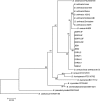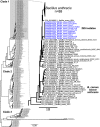Non-Toxin-Producing Bacillus cereus Strains Belonging to the B. anthracis Clade Isolated from the International Space Station
- PMID: 28680972
- PMCID: PMC5487513
- DOI: 10.1128/mSystems.00021-17
Non-Toxin-Producing Bacillus cereus Strains Belonging to the B. anthracis Clade Isolated from the International Space Station
Abstract
In an ongoing Microbial Observatory investigation of the International Space Station (ISS), 11 Bacillus strains (2 from the Kibo Japanese experimental module, 4 from the U.S. segment, and 5 from the Russian module) were isolated and their whole genomes were sequenced. A comparative analysis of the 16S rRNA gene sequences of these isolates showed the highest similarity (>99%) to the Bacillus anthracis-B. cereus-B. thuringiensis group. The fatty acid composition, polar lipid profile, peptidoglycan type, and matrix-assisted laser desorption ionization-time of flight profiles were consistent with the B. cereus sensu lato group. The phenotypic traits such as motile rods, enterotoxin production, lack of capsule, and resistance to gamma phage/penicillin observed in ISS isolates were not characteristics of B. anthracis. Whole-genome sequence characterizations showed that ISS strains had the plcR non-B. anthracis ancestral "C" allele and lacked anthrax toxin-encoding plasmids pXO1 and pXO2, excluding their identification as B. anthracis. The genetic identities of all 11 ISS isolates characterized via gyrB analyses arbitrarily identified them as members of the B. cereus group, but traditional DNA-DNA hybridization (DDH) showed that the ISS isolates are similar to B. anthracis (88% to 90%) but distant from the B. cereus (42%) and B. thuringiensis (48%) type strains. The DDH results were supported by average nucleotide identity (>98.5%) and digital DDH (>86%) analyses. However, the collective phenotypic traits and genomic evidence were the reasons to exclude the ISS isolates from B. anthracis. Nevertheless, multilocus sequence typing and whole-genome single nucleotide polymorphism analyses placed these isolates in a clade that is distinct from previously described members of the B. cereus sensu lato group but closely related to B. anthracis. IMPORTANCE The International Space Station Microbial Observatory (Microbial Tracking-1) study is generating a microbial census of the space station's surfaces and atmosphere by using advanced molecular microbial community analysis techniques supported by traditional culture-based methods and modern bioinformatic computational modeling. This approach will lead to long-term, multigenerational studies of microbial population dynamics in a closed environment and address key questions, including whether microgravity influences the evolution and genetic modification of microorganisms. The spore-forming Bacillus cereus sensu lato group consists of pathogenic (B. anthracis), food poisoning (B. cereus), and biotechnologically useful (B. thuringiensis) microorganisms; their presence in a closed system such as the ISS might be a concern for the health of crew members. A detailed characterization of these potential pathogens would lead to the development of suitable countermeasures that are needed for long-term future missions and a better understanding of microorganisms associated with space missions.
Keywords: Bacillus; Bacillus anthracis; Bacillus cereus; ISS; genomics; spores.
Figures




Similar articles
-
Characterization and taxonomic clarification of a non-emetic, radiation-resistant Bacillus cereus strain mrbd isolated from a 60Co irradiator pool.Infect Genet Evol. 2025 Sep;133:105796. doi: 10.1016/j.meegid.2025.105796. Epub 2025 Jul 8. Infect Genet Evol. 2025. PMID: 40639557
-
Complete sequence analysis of novel plasmids from emetic and periodontal Bacillus cereus isolates reveals a common evolutionary history among the B. cereus-group plasmids, including Bacillus anthracis pXO1.J Bacteriol. 2007 Jan;189(1):52-64. doi: 10.1128/JB.01313-06. Epub 2006 Oct 13. J Bacteriol. 2007. PMID: 17041058 Free PMC article.
-
Genomic Characterization and Copy Number Variation of Bacillus anthracis Plasmids pXO1 and pXO2 in a Historical Collection of 412 Strains.mSystems. 2018 Aug 14;3(4):e00065-18. doi: 10.1128/mSystems.00065-18. eCollection 2018 Jul-Aug. mSystems. 2018. PMID: 30116789 Free PMC article.
-
What sets Bacillus anthracis apart from other Bacillus species?Annu Rev Microbiol. 2009;63:451-76. doi: 10.1146/annurev.micro.091208.073255. Annu Rev Microbiol. 2009. PMID: 19514852 Review.
-
Characterization and comparative genomic analysis of bacteriophages infecting members of the Bacillus cereus group.Arch Virol. 2014 May;159(5):871-84. doi: 10.1007/s00705-013-1920-3. Epub 2013 Nov 22. Arch Virol. 2014. PMID: 24264384 Review.
Cited by
-
Space omics research in Europe: Contributions, geographical distribution and ESA member state funding schemes.iScience. 2022 Feb 15;25(3):103920. doi: 10.1016/j.isci.2022.103920. eCollection 2022 Mar 18. iScience. 2022. PMID: 35265808 Free PMC article. Review.
-
The International Space Station Environment Triggers Molecular Responses in Aspergillus niger.Front Microbiol. 2022 Jun 30;13:893071. doi: 10.3389/fmicb.2022.893071. eCollection 2022. Front Microbiol. 2022. PMID: 35847112 Free PMC article.
-
Advances in space microbiology.iScience. 2021 Apr 3;24(5):102395. doi: 10.1016/j.isci.2021.102395. eCollection 2021 May 21. iScience. 2021. PMID: 33997680 Free PMC article. Review.
-
Pangenomic Approach To Understanding Microbial Adaptations within a Model Built Environment, the International Space Station, Relative to Human Hosts and Soil.mSystems. 2019 Jan 8;4(1):e00281-18. doi: 10.1128/mSystems.00281-18. eCollection 2019 Jan-Feb. mSystems. 2019. PMID: 30637341 Free PMC article.
-
Fundamental Biological Features of Spaceflight: Advancing the Field to Enable Deep-Space Exploration.Cell. 2020 Nov 25;183(5):1162-1184. doi: 10.1016/j.cell.2020.10.050. Cell. 2020. PMID: 33242416 Free PMC article. Review.
References
-
- Benardini JN, Vaishampayan PA, Schwendner P, Swanner E, Fukui Y, Osman S, Satomi M, Venkateswaran K. 2011. Paenibacillus phoenicis sp. nov., isolated from the Phoenix Lander assembly facility and a subsurface molybdenum mine. Int J Syst Evol Microbiol 61:1338–1343. doi:10.1099/ijs.0.021428-0. - DOI - PubMed
LinkOut - more resources
Full Text Sources
Other Literature Sources
Molecular Biology Databases
Research Materials

